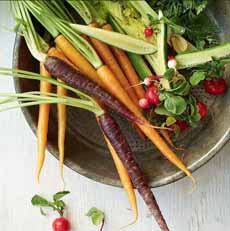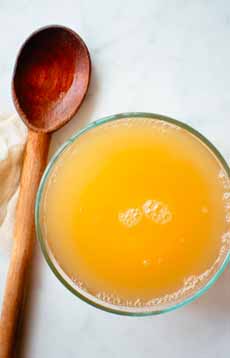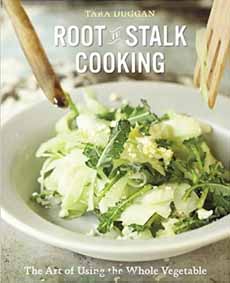TIP OF THE DAY: Make Stocks & Soups From Trimmings
|
|
When we were quite young, a friend of the family was watching our mom cut vegetables for soup, and toss the trimmings. He had grown up on a farm in Sicily, and said: “We never threw away anything edible, not the smallest part. If we could have saved it, we’d have cooked the ‘oink’ from the pig.”
That’s how it’s been through history, except in affluent homes in affluent countries, whose denizens weren’t scraping for every bit to eat. Modern cooks who want to minimize waste know that they can add flavor to homemade stocks by saving the carrot peels, celery leaves and trimmed ends, the last scrap of onion before the root, parsley and other herb stalks, wilted herbs, sprouted garlic and onions, the tops of scallions, and many vegetable trimmings. Consider anything that isn’t rotten or moldy, or on the “Avoid” list below. Limp vegetables? Stock. Herbs that have begun to yellow? Stock. Wash and trim the vegetables as usual. Then set the trimmings aside and let them dry a little bit to remove moisture before you bag them. Toss the ends, leaves, peel, roots and stalks into the same freezer bag—and feel good about not wasting money or contributing to a landfill. (If you’re planning to use them in a week, store in the produce drawer with the air pressed out of the bag.) When you’re ready to make stock, plan for 2 cups of trimmings per quart of stock from vegetables. And note that the venerable chef Jacques Pépin, an instructor at French Culinary Institute in New York City, always checks his students’ waste bins to see what they’ve thrown away. For him, scraps are more about flavor and less about thriftiness (although his wife has blocked the process at home; it drove her bonkers). SAVE THESE TRIMMINGS What not to use: vegetables with very strong flavors: |
|
|
________________
*That being said, we once cooked a ton of beets and had lots of leftover red “beet water.” We reduced it and used it to cook white rice. It was fun. |
||
|
PLAN A: READY TO MAKE VEGETABLE STOCK? The difference between stock (photo #2) and broth is that broth is seasoned and ready to consume. Stock is left unseasoned, to provide flexibility for different recipes. You can use vegetable stock in braises, poaching, sauces, soups, stir fries and stews etc. We use it to cook rice and grains, including risotto: half-and-half water and stock (or all stock, if we have too much). Season it for udon or other Asian-style noodle soup. Substitute for cream in mashed potatoes, add to the vegetable steamer to infuse flavor, and many hundreds of other ideas. Ingredients For 2 Quarts Of Stock 1. HEAT the oil in a stockpot over medium-high heat. Add the vegetables and herbs and cook, stirring occasionally, until the vegetables begin to soften, 3-5 minutes or so. 2. ADD 4 quarts cold water and bring to a boil. Reduce the heat and simmer until the stock is reduced by half. This should take about 1-1 1/2 hours. 3. STRAIN the stock through a fine-mesh sieve into a large bowl and discard the solids. Let cool. 4. USE immediately, or transfer to pint or quart containers (or freezer bags, if you prefer), portioning it based on how you think you’ll use it. Ideally use frozen stock within three months. |

[4] Trimmings cooked, pureed and turned into a sauce (photo courtesy Vital Choice). [5] This cookbook has delicious recipes for every part of vegetables (photo courtesy Ten Speed Press_. |
|
|
PLAN B: READY TO MAKE SOUP OR SAUCE? Make soup. Cook the trimmings (in stock or broth) and turn them into a puréed vegetable soup, like the one in photo #3. You can also turn the pureed vegetables into a sauce (photo #4). Good news: Plan B lets you use all the cruciferous vegetables. All those broccoli stalks and cauliflower stems: delicious! We cook them even when we aren’t making soup. Cook, taste and season. Dilute as desired with stock or milk and voilà: Your trimmings are now a tasty soup. And you’ll feel good about that! There’s an entire cookbook devoted to using every part of the vegetable (photo #5): From Root To Stalk. |
||



